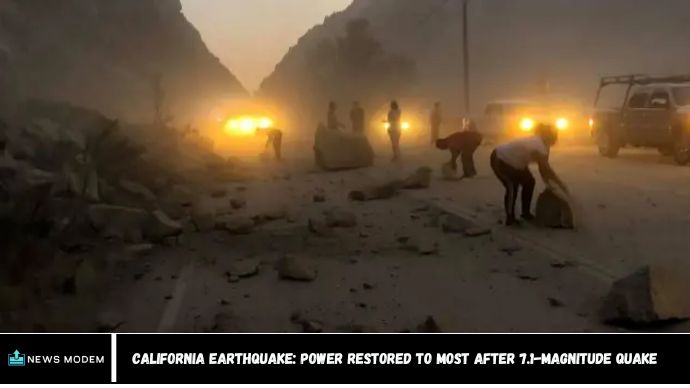California Earthquake: Power Restored to Most After 7.1-Magnitude Quake A 7.1-magnitude earthquake has struck parts of Southern California, marking the strongest tremor to hit the region in 20 years. The quake occurred at a shallow depth of 0.9 km (0.6 miles), with its epicenter near Ridgecrest, located approximately 240 km northeast of Los Angeles.
Initial reports indicated significant concern, but emergency officials now say that the damage was less severe than expected. Power has been restored to most of the affected areas, and food stores have resumed operations. Additionally, all damaged roads have been reopened, though crews are still working to assess the full extent of the aftermath.
Around 3,000 people in Ridgecrest and nearby areas were temporarily without power. Fortunately, officials reported only minor to moderate injuries and confirmed that there have been no fatalities, which they called a fortunate outcome.
Seismologist Dr. Lucy Jones warned that this event could be part of a series of aftershocks, describing it as an “earthquake sequence.” She cautioned that future tremors are likely, with a 10% chance of another quake of similar magnitude or even larger within the next week.
However, Dr. Jones stated that the quake is unlikely to trigger shocks on other fault lines. The earthquake’s tremors were felt far beyond California, reaching Las Vegas in Nevada and even parts of Mexico.
The California Earthquake: Key Facts and Immediate Impact
The 7.1-magnitude earthquake hit near Ridgecrest, California, located about 125 miles north of Los Angeles. While earthquakes of this magnitude are relatively rare in California, they’re part of the state’s seismic risk. Here’s a breakdown of the immediate impact:
Key Earthquake Facts:
- Date and Time: July 6, 2019, at 8:19 p.m. local time.
- Magnitude: 7.1 on the Richter scale, making it one of the largest earthquakes in the area in over 20 years.
- Epicenter Location: Near Ridgecrest, CA, in the Mojave Desert region.
- Duration: The quake lasted around 20 seconds but was powerful enough to shake large areas of Southern California.
Initial Damage:
- Power Outages: Approximately 20,000 people were affected by power outages in the immediate aftermath.
- Infrastructure Damage: Some buildings, roads, and structures sustained visible damage. Cracks appeared in the ground, and several gas leaks were reported.
- Injuries: While there were reports of injuries, they were relatively minor, and there were no immediate fatalities.
Power Restoration: How California Managed the Recovery
After the earthquake, utilities and emergency services quickly went to work to restore power and ensure safety across the affected areas. Within hours of the quake, power was restored to most homes and businesses, thanks to efficient recovery efforts and pre-existing disaster plans.
Key Recovery Actions:
- Power Outage Response: Utility companies, including Southern California Edison, worked swiftly to restore electricity to homes and businesses. By the morning of July 7, most of the affected areas had their power back on.
- Safety and Inspections: Crews conducted inspections of gas lines and infrastructure to prevent fires and other hazards. Seismic retrofitting of vulnerable buildings also became a priority.
- Communication: Local and state authorities communicated regularly with residents to provide updates and ensure they understood safety protocols, including aftershocks.
Aftershocks and Ongoing Risks
In the wake of the 7.1-magnitude quake, aftershocks continued to shake the region. Over the next few days, multiple aftershocks—some as strong as 6.4-magnitude—reminded residents that the risks were far from over.
Important Considerations:
- Aftershock Preparedness: Aftershocks can occur minutes, hours, or even days after the main earthquake. Residents should be aware that seismic activity may persist.
- Seismic Risk Zones: California sits on several major fault lines, including the famous San Andreas Fault, making it highly vulnerable to future earthquakes.
California’s Long-Term Earthquake Preparedness
The 7.1-magnitude earthquake was a wake-up call for many Californians. While the immediate recovery was swift, the event highlighted the importance of being prepared for future earthquakes.
Key Long-Term Strategies:
- Building Retrofitting: Many older buildings are vulnerable to seismic activity. California has ongoing programs to encourage earthquake-resistant building designs and retrofit older structures.
- Public Education: Residents are encouraged to have an emergency kit, make a family plan, and regularly practice earthquake drills.
- Investment in Technology: Earthquake early warning systems, such as the ShakeAlert system, are helping to provide real-time alerts to minimize damage and save lives.
FAQs:
1. What was the magnitude of the California earthquake?
The earthquake had a 7.1-magnitude, striking near Ridgecrest, California.
2. How long did the earthquake last?
The earthquake lasted for about 20 seconds, but its impact was felt for much longer due to aftershocks.
3. How quickly was power restored after the quake?
Most areas had their power restored within hours, thanks to effective recovery efforts.
4. What areas were affected by the earthquake?
The earthquake affected Southern California, especially near Ridgecrest, but was felt as far as Los Angeles and beyond.
5. Were there any major injuries or fatalities?
There were no reported fatalities, though there were minor injuries and significant infrastructure damage.
6. How can Californians prepare for future earthquakes?
Residents should focus on building retrofitting, having an emergency kit, and staying informed about earthquake preparedness.
Conclusion
The 7.1-magnitude earthquake was a reminder of California’s constant seismic risk. While the immediate recovery was quick, ongoing earthquake preparedness remains essential for residents and authorities alike. By investing in seismic retrofitting, improving early warning systems, and educating the public, California can mitigate the impact of future earthquakes. As the state continues to strengthen its response strategies, the lessons learned from this earthquake will guide efforts to safeguard lives and infrastructure in the face of inevitable seismic events.

